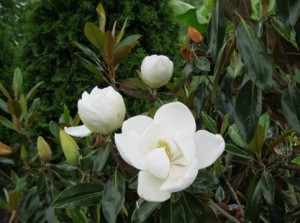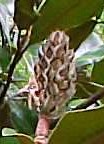 Native to the coast of southeeastern United States, these tall broadleaf evergreen trees grow in moist wooded areas, along riverbanks as well as in parks and gardens, and along streets. Their stately presence is a common sight where their leaves and flowers are treasured by many. The oval leathery leaves have a glossy, dark green upper surface, and a brown hair-covered lower surface. They are especially prized for Christmas decorations. The cream-colored flowers are cup-shaped, very fragrant and up to twelve inches across. They are borne singly in spring and periodically throughout the growing season. The cone-like fruits that ripen in autumn are four inches long and bear bright red seeds that are attractive to birds. Southern magnolia is most often used as a specimen tree but can be grown as espalier, a hedge or screen. Leaf drop, however, can create a litter problem in gardens or on lawns. Many cultivars are available varying in several characteristics including size, hardiness, and age of first bloom.
Native to the coast of southeeastern United States, these tall broadleaf evergreen trees grow in moist wooded areas, along riverbanks as well as in parks and gardens, and along streets. Their stately presence is a common sight where their leaves and flowers are treasured by many. The oval leathery leaves have a glossy, dark green upper surface, and a brown hair-covered lower surface. They are especially prized for Christmas decorations. The cream-colored flowers are cup-shaped, very fragrant and up to twelve inches across. They are borne singly in spring and periodically throughout the growing season. The cone-like fruits that ripen in autumn are four inches long and bear bright red seeds that are attractive to birds. Southern magnolia is most often used as a specimen tree but can be grown as espalier, a hedge or screen. Leaf drop, however, can create a litter problem in gardens or on lawns. Many cultivars are available varying in several characteristics including size, hardiness, and age of first bloom.

Type: Broadleaf evergreen tree
Outstanding Features: Leaves; flowers
Form: Pyramidal to oval; dense
Growth Rate: Moderate
Bloom: Creamy-white flowers up to 12” across are produced in spring and periodically through summer, into fall.
Size: 60-80’ H x 30-50’ W
Light: Full sun to shade
Soil: Rich, moist,well-drained
Hardiness: Zones 7-9
Care: Clean up leaves and fruits as they drop.
Pests and Diseases: Scale, aphids, leafspot
Propagation: Seed, cuttings, budding, grafting
Outstanding Selection:
-
‘Little Gem’ (10-20’ tall; blooms when young)
‘Bracken’s Brown Beauty’ (30’, hardy to zone 6).
